In her 2004 paper—”New Theoretical Approaches for Human-Computer Interaction“—Yvonne Rogers described how the history of human-computer interaction has both benefited and suffered from appropriating established theories from older disciplines. HCI imports concepts (like Situated Action, Ethnography and Activity Theory) and applies them to the study of interfaces. However, that theoretical work has a difficult time finding a place in the practical world of design. A similar challenge was presented at the annual CHI conference in San Jose last April by Carnegie-Mellon University professors John Zimmerman, Jodi Forlizzi and Shelley Evenson. Their paper suggested a framework that puts the interaction designers as the interpreter between researchers and practitioners.
This main theme of disconnection between theory and practice was meant as a call to HCI theorists to improve both the communication and the pragmatics of technique, moving new ideas from abstraction to doable activities. That disconnection applies in the other direction, too, in how we perceive and intervene in the evolution of the World Wide Web. This article explores the role design has in what comes next.
What Version Are We Using?
The term “Web 2.0” arose with a conference held in San Francisco in October 2004, featuring an A-list of speakers that included Jeff Bezos (Amazon.com), Mark Cuban (HDNet), Marc Andreessen (Mosaic, Ning), Lawrence Lessig (Creative Commons), and David Sifry (Technorati). A year later, the term had reached such a state of confusion—is it a philosophy, a paradigm shift, or a marketing buzzword?—that Tim O’Reilly attempted to sort out with a summary article describing the various flavors of definition.
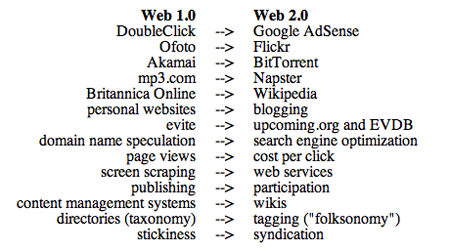
In 2005, Tim O’Reilly provided some examples of how applications evolved.
Web 2.0 is a term that has been misappropriated in many ways. It is a production process and a consumer participation paradigm, a phrase with marketing cache and a justification for new startups to claim a spot on the envelope. Fifteen months after O’Reilly’s definitive guide, the term was refactored into the following:
Web 2.0 is the business revolution in the computer industry caused by the move to the internet as platform, and an attempt to understand the rules for success on that new platform. Chief among those rules is this: Build applications that harness network effects to get better the more people use them. (This is what I’ve elsewhere called “harnessing collective intelligence.”)
source: O’Reilly Radar, “Web 2.0 Compact Definition: Trying Again” (December 10, 2006)
This fall, O’Reilly returned to the origins of the term—as a proclamation that the Internet had survived the Dot Com crash, not to represent an iteration of the brave new world.
The impetus for that clarification was a blogstorm of discussion around “Web 3.0.” Given its predecessor the term was inevitable, but credit is awarded to Jeffrey Zeldman, whose critique of Web 2.0 did the honors. What is not as certain is what this next phase of the Internet will look like.
Before exploring some of these new visions, it is important to do two things. First, we must recognize that the discussion seems to be led by practitioners looking to create theory—the opposite problem described by Rogers for the field of HCI. Second, before we can answer the question of what is to be designed, we must tackle the more fundamental question of why design at all.

Why Design?
Phillipe Starck’s spring lecture at TED was made available earlier this month. In it, Starck explained the reality of our existence:
Because the bacteria we was had no idea of what we are today. And today, we have no idea of what we shall be in 4 billion years.
He goes on to explain this is his motivation to continue to design comparably trivial items, such as toilet seats and toothbrushes. Take the context you have now—the materials, the knowledge, the resources, the social structure—and do the best you can to create wonderful things. The past is embedded in everything we do, and the future is completely unknown. “Now you have a duty,” Starck tells the next generation of designers. “Invent a new story. Invent a new poetry. The only rule is, we have not to have any idea about the next story.”
Whether or not Starck’s answer is correct, the question has merit. Why design? The fields of HCI and design are filled with attempts to answer the question of What to design. We study methods and techniques, ways of take a design from grounded concept to profitable product. We shift our focus on where the design resides. But the best we can do to answer the question of Why is to speak vaguely about personal passion or the noble goals of selecting a future. Why is the foundation for What.
We clearly don’t design for the purpose of creating opportunities to press buttons or pull down menus. Given any system, the motivation of a user is not to interact with a machine. Ultimately, the goal is connection with others.
In her 2006 book This Changes Everything, author Christina Robb details the history of three pioneering women whose groundbreaking work might transform psychology, and thus all the things that discipline touches. Carol Gilligan, Jean Baker Miller and Judith Lewis Herman learned their trade in a man’s world, where the basic assumptions about behavior were blind to the experiences of everyone who isn’t white and male. Gilligan’s landmark work—In a Different Voice—challenged the established understanding of morality by showing that differences exist between the genders in how they deal with and evaluate responsibility to self and others. By the mid 1980s, a number of feminist psychologists had managed to find each other, listen to each other’s experiences, and plant the seeds for a new way of thinking about health.
Relational-Cultural Theory (RCT) describes a healthy relationship as one that is capable of moving in and out of connection. Rather than strength being defined as overcoming interactions with others to become self-sufficient and independent, our strength resides in our ability to share dependence with each other. RCT proposes that growth-fostering relationships—defined by their cultural context—are a central human necessity throughout our lives; chronic disconnections are the source of problems.
When Brandon Schauer described the long wow this fall as “achieving long-term customer loyalty through systematically impressing your customers again and again,” he is describing business in terms of connection, disconnection and reconnection. The design of business is not about promotions, discounts or the widget itself. It is about growing an authentic relationship. When Sharon Lee writes, “A good website is built on two basic truths—that the internet is an interactive medium and that the end user is in fact human,” she is acknowledging that the purpose of web design is to connect the humans on the back end with the ones facing the buttons. The mutual empathy of RCT is the user experience of contemporary design.
The Why of design is simple: to facilitate human connection.
What Do We Design?
With connection as our foundation, our concept of design shifts. Design can be defined in many ways, from visuals to widgets to interaction and experience. Throughout the history of computer-based design, however, the common theme has been to express design as either an object or a process to produce an object.
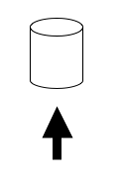 When computers were young and enormous, their entire reason for being was computational. The code-breaking problems of World War II placed a premium on algorithms and functionality. The only users were experts, so all of the design attention was given to the machines and the technology that supported them. The constraints of the early days would quickly be overcome, but that was not known to the engineers designing computers and programming at the time. The result was a period of establishing persistent norms that defined our patterns of design in the future. Design was the object at the end of the process.
When computers were young and enormous, their entire reason for being was computational. The code-breaking problems of World War II placed a premium on algorithms and functionality. The only users were experts, so all of the design attention was given to the machines and the technology that supported them. The constraints of the early days would quickly be overcome, but that was not known to the engineers designing computers and programming at the time. The result was a period of establishing persistent norms that defined our patterns of design in the future. Design was the object at the end of the process.
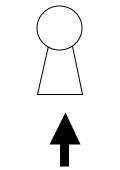 Human-computer interaction emerged in the 1980s out of a need to design for the user. As computers shrunk from rooms to desktop terminals, the problems became less about solving equations and more about improving business efficiency. The expert users gave way to the professional ones working as cogs in the wheels of the company machine. Human factors and ergonomics were created to deal with the physical limitations of these biological parts, as design attention shifted from the tool to the controller. Even by the time HCI was realizing that people should enjoy their experience using a computer, the design still considered the user an object to be manipulated through heuristics and bigger buttons. Design was the person expected to use our tools.
Human-computer interaction emerged in the 1980s out of a need to design for the user. As computers shrunk from rooms to desktop terminals, the problems became less about solving equations and more about improving business efficiency. The expert users gave way to the professional ones working as cogs in the wheels of the company machine. Human factors and ergonomics were created to deal with the physical limitations of these biological parts, as design attention shifted from the tool to the controller. Even by the time HCI was realizing that people should enjoy their experience using a computer, the design still considered the user an object to be manipulated through heuristics and bigger buttons. Design was the person expected to use our tools.
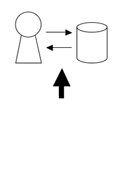 User Experience (UX) picked up on this notion of pleasurable state of mind in the 1990s—thanks in no small part to the influx of theory described by Rogers—and shifted the focus of design from the usability of windows, icons, menus and pointers to how a person might feel as the interaction takes place. Computers had moved well beyond businesses by this point and past the tethered desktop into mobile devices and appliances. Individuals, increasingly unable to fit into a nice demographic bucket, each had their own needs and requirements, reacting to the same tools in very different ways. Erik Stolterman has suggested that we objectify the interaction between the user and the artifact, turning the design into the interaction itself but leaving it in an object-oriented paradigm.
User Experience (UX) picked up on this notion of pleasurable state of mind in the 1990s—thanks in no small part to the influx of theory described by Rogers—and shifted the focus of design from the usability of windows, icons, menus and pointers to how a person might feel as the interaction takes place. Computers had moved well beyond businesses by this point and past the tethered desktop into mobile devices and appliances. Individuals, increasingly unable to fit into a nice demographic bucket, each had their own needs and requirements, reacting to the same tools in very different ways. Erik Stolterman has suggested that we objectify the interaction between the user and the artifact, turning the design into the interaction itself but leaving it in an object-oriented paradigm.
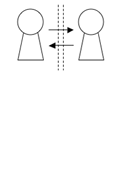 From a relational perspective, it is neither the artifact nor the individual that is as important as the interaction. This clearly distances design from the first two views of design-as-artifact and design-as-user. It is also potentially distinguishable from the Stolterman notion of design-as-interaction, provided the interaction continues to be defined as the relationship between the user and the tool. If the reason we design is to facilitate human connection, then we must also see the interface as the medium between people. This is perhaps a bit nuanced, but it is a powerful distinction to make. Design is setting the stage so beneficial interactions can occur, not about the players.
From a relational perspective, it is neither the artifact nor the individual that is as important as the interaction. This clearly distances design from the first two views of design-as-artifact and design-as-user. It is also potentially distinguishable from the Stolterman notion of design-as-interaction, provided the interaction continues to be defined as the relationship between the user and the tool. If the reason we design is to facilitate human connection, then we must also see the interface as the medium between people. This is perhaps a bit nuanced, but it is a powerful distinction to make. Design is setting the stage so beneficial interactions can occur, not about the players.
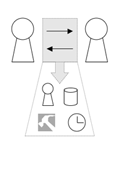 A physicist named Michelson once tested the existence of an invisible substance that filled the universe, always at rest and permeating all matter. Although ether was disproved as a physical property, it may still have life as a metaphor for design. The interaction ether is filled with any number of people, artifacts, tools and constraints. It has context dependent on time, sequence and cultural awareness. It is a space in which interactions and experiences occur. Design as ether requires that we understand not the specifics but the dynamics of the situation. People flow in and out of connection with each other. Strength comes in being able to reconnect, to have both the resources and the experience in how to wield them. Designers, by knowing well the relationships between objects in this environment, can help shape opportunities for quality interaction. Design facilitates a connection through an intentional change in the interaction ether.
A physicist named Michelson once tested the existence of an invisible substance that filled the universe, always at rest and permeating all matter. Although ether was disproved as a physical property, it may still have life as a metaphor for design. The interaction ether is filled with any number of people, artifacts, tools and constraints. It has context dependent on time, sequence and cultural awareness. It is a space in which interactions and experiences occur. Design as ether requires that we understand not the specifics but the dynamics of the situation. People flow in and out of connection with each other. Strength comes in being able to reconnect, to have both the resources and the experience in how to wield them. Designers, by knowing well the relationships between objects in this environment, can help shape opportunities for quality interaction. Design facilitates a connection through an intentional change in the interaction ether.
What’s Next?
From Zeldman’s iteration in January 2006 to last month’s blog debates, the two dominant views of what the Web will become are technology based. In one camp, the future Web is as an evolution of artificial intelligence—computer collaborating with other computers in a semantically tagged network of information—and in another, it is a massively open database, tied together through special domain names, web services, and open standards. Perhaps Nova Spivack‘s all-encompassing vision of a third generation web—ubiquitous connectivity, open technologies and identity, distributed computing, intelligent web—is the next evolution, Starck’s “next story.”
If the Web were viewed only as a network of machinery serving documents, those might be good bets. The Web, however, is merely the infrastructure for human connection. Web 3.0, then, might be more about the people than the architecture.
Of all the answers the major players have offered over the past few years, the one that comes closest to placing humanity in center stage in the evolution is from Jerry Yang, founder of Yahoo! In Dan Farber’s coverage of TechNet’s Innovation Summit in November 2006, Yang was credited with the following (boldface added):
Web 2.0 is well documented and talked about. The power of the Net reached a critical mass, with capabilities that can be done on a network level. We are also seeing richer devices over last four years and richer ways of interacting with the network, not only in hardware like game consoles and mobile devices, but also in the software layer. You don’t have to be a computer scientist to create a program. We are seeing that manifest in Web 2.0 and 3.0 will be a great extension of that, a true communal medium…the distinction between professional, semi-professional and consumers will get blurred, creating a network effect of business and applications.
That is a message of co-creation. Of empowerment. Of placing the design of interaction spaces above the design of objects, no matter the form they take.